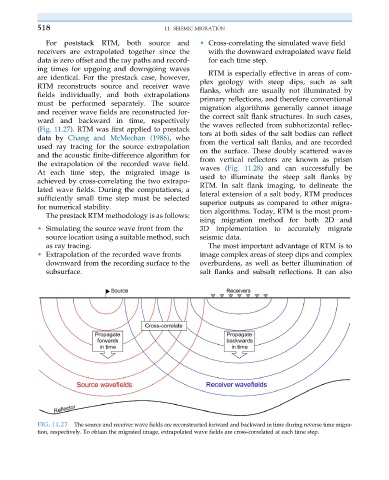Page 527 - Acquisition and Processing of Marine Seismic Data
P. 527
518 11. SEISMIC MIGRATION
For poststack RTM, both source and • Cross-correlating the simulated wave field
receivers are extrapolated together since the with the downward extrapolated wave field
data is zero offset and the ray paths and record- for each time step.
ing times for upgoing and downgoing waves RTM is especially effective in areas of com-
are identical. For the prestack case, however, plex geology with steep dips, such as salt
RTM reconstructs source and receiver wave
flanks, which are usually not illuminated by
fields individually, and both extrapolations
primary reflections, and therefore conventional
must be performed separately. The source
migration algorithms generally cannot image
and receiver wave fields are reconstructed for-
the correct salt flank structures. In such cases,
ward and backward in time, respectively
the waves reflected from subhorizontal reflec-
(Fig. 11.27). RTM was first applied to prestack
tors at both sides of the salt bodies can reflect
data by Chang and McMechan (1986),who
from the vertical salt flanks, and are recorded
used ray tracing for the source extrapolation
on the surface. These doubly scattered waves
and the acoustic finite-difference algorithm for
from vertical reflectors are known as prism
the extrapolation of the recorded wave field.
waves (Fig. 11.28) and can successfully be
At each time step, the migrated image is
used to illuminate the steep salt flanks by
achieved by cross-correlating the two extrapo-
RTM. In salt flank imaging, to delineate the
lated wave fields. During the computations, a
lateral extension of a salt body, RTM produces
sufficiently small time step must be selected
superior outputs as compared to other migra-
for numerical stability.
tion algorithms. Today, RTM is the most prom-
The prestack RTM methodology is as follows:
ising migration method for both 2D and
• Simulating the source wave front from the 3D implementation to accurately migrate
source location using a suitable method, such seismic data.
as ray tracing. The most important advantage of RTM is to
• Extrapolation of the recorded wave fronts image complex areas of steep dips and complex
downward from the recording surface to the overburdens, as well as better illumination of
subsurface. salt flanks and subsalt reflections. It can also
FIG. 11.27 The source and receiver wave fields are reconstructed forward and backward in time during reverse time migra-
tion, respectively. To obtain the migrated image, extrapolated wave fields are cross-correlated at each time step.

